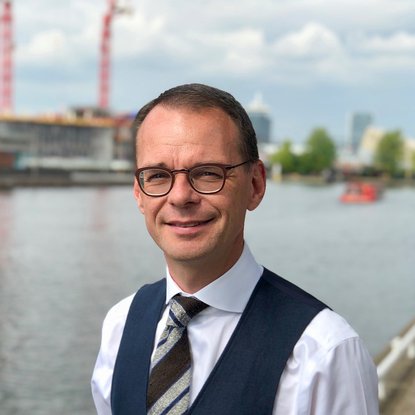At Marineterrein Amsterdam Living Lab, Respyre tests a ‘wall of moss’ as part of the Bio-receptive Concrete project. A section of building 002 on the inner-city test ground has undergone a small metamorphosis in recent weeks: where there used to be a grey wall, a layer of moss is now carefully beginning to develop in the shelter of a protective tarp.
“The moss grows nicely, and it also positively affects biodiversity: we can see that the moss-covered wall already invited spiders and ants. If all goes well, in eight weeks we’ll see a vertical oasis of green and cooling moss here.”
Auke Bleij | Business and Technology Developer | Respyre

Moss to help solve the city’s climate challenges
Cities experience increasing pressure due to climate change and urbanization. Heat stress, air pollution, a lack of biodiversity, and pressure on sewers during heavy rainfall impact city residents’ quality of life. Moss potentially offers a solution for many urban challenges at once. Among others, it cools the environment, absorbs CO₂ and particulate matter, is soundproof, stimulates biodiversity, and retains water. Also, it insulates the buildings on which it grows, reducing the need for electricity for air conditioning in the summer.
This makes moss a special kind of plant. And if this wasn’t enough: it’s also a plant that is tough and can survive long periods of drought. And unlike other plants, it does not affect the structure of buildings because it has no roots and attaches to the wall like Velcro.
A special concrete to grow moss on any building
Many buildings are made of material on which moss can’t grow, including building 002 at Marineterrein Amsterdam. Respyre developed a special type of concrete that helps moss to attach itself to a wall.
Respyre’s ‘bio-receptive concrete’ can be plastered or poured on existing facades or applied as a facade plate. The airy, open structure of this concrete, which is enriched with nutrients, makes for the ideal soil for moss to grow. This way we can allow moss to grow on any building.
Collecting moss from to-be demolished buildings
Once the concrete layer is in place, the moss can be applied. Moss consists of traces. Respyre obtains these traces by ‘harvesting' from old buildings that are on the demolition list and whose concrete is in poor condition. These buildings are not a good place for humans to live, but it is for moss to grow.
The collected moss is pulverized into powder and mixed with water and nutrients until a porridge-like mixture is formed. This is applied on a wall that has been plastered with special concrete. After the application, the wall is covered so it's not exposed to the elements. When the moss is sufficiently attached, the tarp gets removed and nature does its job.
A CO₂-negative project
The entire moss project is CO₂-negative. Firstly because Respyre collects moss from buildings that are to be demolished for the production process of the bio-receptive concrete and secondly, when applied on a wall this moss eventually absorbs more CO₂ than the production of the concrete emits.
The first step: collecting moss from old buildings
“We already know that realizing a ‘moss wall’ is relatively cheap and hardly requires any maintenance. If we can demonstrate that moss walls positively contribute to enhancing urban liveablity, it can also become interesting for project developers and social rental sector alike.”
Auke Bleij | Business and Technology Developer | Respyre

Scaling up to more moss walls for liveable cities
The moss wall experiment at Marineterrein is realized together with Delft University of Technology (TU Delft), Wageningen University & Research (WUR), Marineterrein Amsterdam Living Lab (MALL) – the latter being a test area for scalable urban innovation.
This collaboration allows Respyre to research the effects of the moss-covered wall, to what extent moss walls can have a positive effect on the liveability of the city. Here Respyre can perfect techniques and hopefully reduce the production costs even further based on the results.
Respyre foresees a bright future for moss in the city. Like other projects within MALL, the intention is to apply the experience and knowledge gained on a larger scale after an experimental phase. Ultimately, Respyre wants to take this beyond buildings only and, for example, create green noise barriers along freeways and cover bridge piers with moss.
The goal? To turn every gray spot in the Netherlands green and create a more sustainable and cooler (urban) environments where people reap the benefits.
For this article AMS Institute’s Yemoï Hoeben collaborated with Sjoerd Ponstein (Bureau Marineterrein). Many thanks to Auke Bleij (Business and Technology Developer at Respyre) for the input during the interview.
Read the Dutch article on marineterrein.nl

